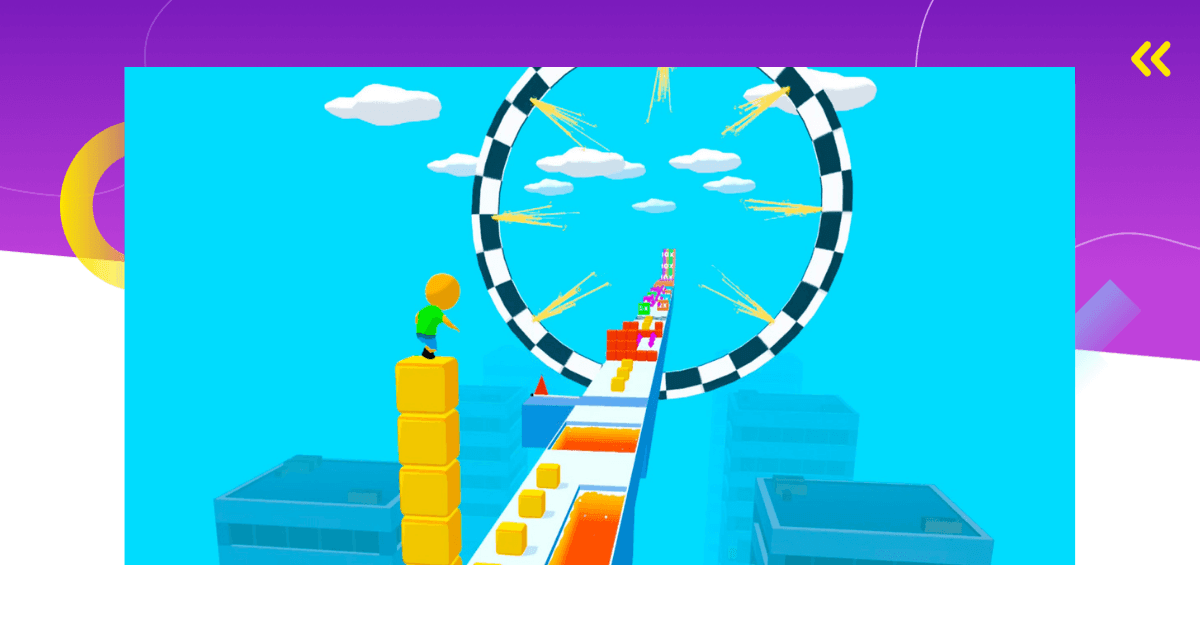Wondering how to make money from hyper-casual games?
You’ve come to the right place.
By reading this article, you will learn about the main strategies hyper-casual game developers use to make the big bucks.
Let’s start.
Hyper-Casual Games: Key Characteristics
The sheer nature of hyper-casual games plays a huge role in the way they make money.
Hyper-casual games are simple, free-to-play minimalistic games that are quick to develop. They are usually based on a single mechanic and have short and simple game loops. These loops are infinitely replayable and can be as addictive as chocolate.
Players can figure them out in a matter of seconds and enjoy instant gameplay. Because of their accessibility, they attract wide and diverse audiences, even more so than casual games.
Basically, a grandma and grandson can both enjoy the same hyper-casual game. Also, both of them can become valuable players who bring in a lot of yield for the developer.
Ever since hyper-casual games appeared in 2017, developers have been producing hyper-casual games at an insanely fast pace.
As a result, the market is very saturated.
These games tend to quickly reach the top charts and vanish soon after. However, not all of these games came from major studios. In this subgenre, previously unknown developers frequently make the top charts as well.

The Earning Potential of Hyper-Casual Games
Some industry experts say in a hyper-casual games report, that hyper-casual games are not just a subgenre but a separate business model.
This is because monetizing a hyper-casual game is quite different from other game genres.
To make money off such a game, you need to focus on getting as many players to play. Of course, you should also do everything in your power to make them return.
However, you need to know that these players aren’t exactly loyal. They also don’t spend a lot of time in a single session.
Why is that so? Players primarily play these games to alleviate stress and kill time. For instance, in the doctor’s waiting room or while commuting.
They hardly ever commit to these games.
For this reason, you need to catch them while they’re still there. Developers achieve this by hitting players with the right monetization strategies early in the game.

How to Make Money from Hyper-Casual Games with In-App Ads?
Hyper-casual games are not very sophisticated, and nor are their economies. Most games in this subgenre make money by displaying in-app ads.
When players install a hyper-casual game, they actually expect to see ads. They are used to it and open to seeing them.
It’s up to you to take advantage of this.
Among other things, you need to pick out the suitable formats, track the right metrics and rely on best practices.
Let me guide you through the ground rules of how to make money from hyper-casual games with in-app ads.
Build In Ads From the Start
Here’s a common mistake hyper-casual developers make.
During the development stage of their game, they focus mainly on the gameplay. They probably think to themselves, ”We’ll just throw in a bunch of ads once we’re all done.”
In hyper-casual games, the in-app advertising strategy is as important as the gameplay itself.
This applies to all kinds of hyper-casual games. It makes no difference if your game is based on stacking, timing, or some other mechanic.
When incorporating a mechanic, you’ll need to determine how you will monetize it right away.
Once the game is in test mode, you should be testing how monetization and gameplay work simultaneously. Only this way, you’ll be able to optimize for monetization in the most player-friendly way.

Leverage Interstitial Ads, but with Caution
Interstitial ads are notoriously known for their intrusiveness.
It’s impossible for players not to notice them. After all, they take over their whole screens. Also, players get nothing in return for watching.
Just a chance to enjoy gameplay until the next ad appears.
Even though this sounds like a complete deal-breaker, interstitials are widely used. According to DeltaDNA, as many as 63% of casual/hyper-casual developers display interstitial ads in their games.
It all comes down to how developers integrate these ads into their games.
Incorporate Interstitial Ads Properly
Incorporating interstitial ads the right way is tricky but doable.
Here are some of the things you should be paying attention to.
Interstitial ads should appear in natural gameplay breaks in order to minimize their intrusiveness. For example, before starting or upon finishing a level.
Moreover, it is important they don’t shock players by appearing out of nowhere. To achieve this, you should be showing them after players take certain actions. For example, when they tap the “next level” button. In such situations, players expect to see ads.
Interstitials don’t come in one shape and size.
You can choose to display static interstitials or interactive ones such as video and playable ads. The more interactive the ad type, the players are more likely to engage with it.
Next, it’s good that the ads come with a skip or exit button. You should also test when it’s the best time to display it. In most cases, the skip button appears after three to five seconds.
Finally, you need to be aware your players won’t stick with your game for a long time. For this reason, you need to start displaying interstitial ads from session one.

Utilize Rewarded Video Ads for Better Engagement
Rewarded video ads are a great fit for all sorts of games, including hyper-casual games.
Players like this ad format because they benefit from it. In return for watching an entire ad, they earn in-game rewards (e.g., lives, currency). Players don’t even need to watch the ad – they just need to let it play until it ends.
Since this ad format is non-skippable, it helps prolong player sessions.
Thanks to all of this, rewarded video ads can boost all sorts of metrics for hyper-casual games – from engagement to retention and revenues.
Best Rewarded Video Ad Placements for Hyper-Casual Games
Where can you place rewarded video ads in hyper-casual games?
There are numerous options.
Before creating rewarded video ad placements, you need to get into your players’ heads.
Ask yourself questions like – “Do they need assistance?”, “Where do they need it?”, “What will make them want to start a new level?”, etc.
Once you answer these questions, it’s time to consider possible placements. There are a lot of placement options, but not all are equally suitable for hyper-casual games.
Here are some common rewarded video ad placements in hyper-casual games:
- Ads on the home screen
- “Out of lives” ads
- Daily reward multiplier
- Multiplier at the end of the game
- “One more try” ads
Here’s how some of these placements work in-game.
For example, if players have just reached the dreaded “GAME OVER” screen, you can use ads to fix the situation. A “One more try” or “Revive” ad placement will do the trick.
These options are tempting for players because they allow them to keep playing. They even have the power to boost the players’ emotional commitment to the game.
On the other hand, if players have just passed a level, they are probably quite satisfied. Rewarded video ads can make them even happier, e.g., if you give them the chance to double up the rewards (multiplier at the end of the game) they have earned from passing a level.

Deliver Banner Ads for Uninterrupted UX
Banner ads may be the oldest ad format, but they are far from forgotten. Today, they appear in most hyper-casual games on the market.
Why is that?
Banners don’t significantly interfere with the players’ user experience. This ad format can fit into different parts of the screen.
In most cases, they appear on the game’s home screen.
They can also appear during gameplay, usually on the top or bottom of the screen. This is a good practice for games that come in portrait mode.
All of this makes banners the ideal ad format to combine with other, more intrusive formats.
No, banners should not be your primary monetization method. However, they can be a great source of extra revenue.
As long as you have enough users playing your game, you can get a large number of banner impressions. This means you can count on eCPM payments from ad networks.
Sure, you can expect plenty of impressions, but what about clicks?
Not as much.
The thing is, a lot of players are immune to banner ads. They have seen them so many times in so many different games that they’ve developed “banner blindness”. That’s a real thing, y’all.

Test Ad Frequency
I’m sure you’ve seen a lot of app store reviews for hyper-casual games saying “too many ads”.
Here’s a statistic on this.
According to CleverTap, over 1/3 of hyper-casual gamers churned from a game because they saw too many ads.
But, how do you know how many ads are too many? Is there some kind of tried-and-true number for you to stick with?
According to research on hyper-casual games, the optimal number of ads to show within a minute is two to three (Unity and Adjust). Then again, according to ironSource, players should see three ads in a single session.
The truth is, there is no magical number here. Each game is a case of its own.
All of these best practices are merely starting points for determining ad frequency. The optimal number of ads to display in your hyper-casual game will depend on many different factors. Some of them include:
- The average number of daily sessions
- Average session duration
- Gameplay type
- The usual number of levels players complete in a session
- Ad formats you’re using
- Balancing in-game rewards, ads, and IAPs
Now that you know which factors to consider, you need to test them out. You should A/B test different ad placements, ad formats, and frequency. Only by doing this will you find the sweet spot for your ads.
Go for Longer Ads
Hyper-casual gamers have particular preferences you should know about.
Yes, they are used to seeing ads. They are even used to seeing them frequently.
However, ads that pop up every couple of seconds will annoy even the calmest players. No one wants their gameplay to be constantly interrupted. Players find this aggressive, and it can completely ruin the user experience.
Your players need a break.
According to a hyper-casual gamers report by Facebook Gaming, they prefer a 30-second ad per 10 minutes of gameplay over several shorter ads in the timeframe.
Obviously, hyper-casual gamers don’t mind longer ads if they know their gameplay won’t be interrupted for a while. Therefore, developers should focus on longer ads and reduce ad frequency.

Segment Players
Some say that segmenting players doesn’t make sense for hyper-casual games.
That is a misconception.
Sure, back when hyper-casual games were monetized only with interstitials and banners, there was not much need for segmenting. You would just throw in the same number of ads for everyone and hope for the best.
Today, hyper-casual games usually include different ad formats. Some even include in-app purchases. If this is the case with your game, you can’t treat all of your players the same way.
For example, you can segment players by their ad-watching habits.
Let’s say you’re monetizing your game with interstitial ads and rewarded video ads.
If you have players who regularly watch rewarded video ads, you should spare them from constant interstitials.
One of the main rules is – don’t serve them an ad if they have just finished voluntarily watching an ad. This is a sure way to chase players away from your game.
The thing is, these players are more valuable than others, and they are more likely to play the game for longer.

Make Use of Cross-Promotion
Without large player bases, hyper-casual games are doomed.
For this reason, a lot of hyper-casual developers take part in cross-promotion trades with other developers. They do this by displaying ads for other games.
I know, directing players to competitor games seems crazy.
Then again, think about this.
If a player installed and liked your game, they will probably enjoy a similar one as well. By promoting other hyper-casual games, you’re contributing to the traffic in the subgenre.
This trade is mutually beneficial. Even though you’re losing some players due to other games, you’re getting them from other games as well. As long as these games have stable traffic, the trade makes sense.
Unlike other types of games, hyper-casual games aren’t as focused on player loyalty. There is a chance that players will play more than one hyper-casual title at the same time. Therefore, if players install another game, this doesn’t mean they will immediately churn from yours.
However, if you’re going to utilize cross-promotion, do it wisely.
Don’t display cross-promotion ads as soon as players start playing your game. It is a better idea to start showing them at the point where players usually start dropping off from your game anyway.
Finally, if you have a portfolio of similar games, cross-promotion is a great way to keep players in it. Almost all major hyper-casual publishers are doing this.
How to Make Money From Hyper-Casual Games With In-App Purchases?
It’s common knowledge that hyper-casual games make a living from ad revenue.
As long as they have many users at a scale, there is no need to even think about other revenue streams.
However, this is changing.
Hybrid monetization has been a mobile gaming trend for a while now. A lot of hyper-casual hopped on the bandwagon.
Here’s how they do it.

Types of In-App Purchases in Hyper-Casual Games
In hyper-casual games, you will hardly stumble upon traditional in-app purchases. For instance, currency or boosters to purchase.
Why is that so?
Games that build their economies on IAPs are focused on building long-term relationships with players. These games need to get players hooked, make them invested, and finally – give them reasons to spend.
In the hyper-casual subgenre, these relationships are shorter and not as deep.
Most hyper-casual gamers are looking for a short-time fling, not a long-term relationship. They are even capable of cheating and leaving you for good (if you know what I mean). For this reason, you shouldn’t count on them investing in the relationship as much.
Then again, a small percentage of players will like your game so much that they will crave a premium gameplay experience.
So, if you don’t bring it to the table, you might lose these players.
In hyper-casual games, they typically come in one of these two forms:
- VIP subscription offers
- “Remove ads” offers
VIP subscriptions include a bundle of benefits. For example, a currency bonus, level bonus, ad removal, ongoing daily rewards, etc.
“Remove ads” offers are self-explanatory. They are also frequently called “No Ads”, “Ad-Free”, or something like that. They come in two different forms – either as one-time purchases or subscriptions.
One-time purchases remove ads from the game for good. On the other hand, subscriptions remove them for a set amount of time (e.g., a week, 10 days).
As you can see, both of these offers mainly revolve around removing ads. Ads are the main pain point for hyper-casual gamers. Without them, they can enjoy a clean, distraction-free gameplay experience.
Hyper-Casual Pioneer: Helix Jump by Voodoo Monetization Strategy Analysis
This hyper-casual game has been around since 2018 and has had a lot of success ever since. Helix Jump is a physics game where a ball falls through a series of obstacles.
The goal of the game? Beating one’s own top score.
Since this game has been on the market for so long, it has been tested and tweaked a number of times. It has also earned a lot of money. If there is a developer from whom we should be learning how to make money from hyper-casual games, it’s Voodoo.
To monetize this game, they blend three ad formats – dynamic banner ads, interstitial ads, and rewarded video ads. Besides ads, the game also utilizes one type of in-app purchase.
You may be thinking – “All four? How does this not chase all players away?”
Let’s find out.

Banner Ads
The moment players launch the game for the first time, they can see two banner ads. One of them is placed on the game’s home screen, while the other is at the bottom of the screen.
The home screen placement is reserved for cross-promotion. Here, players can see dynamic previews of other games by Voodoo that may catch their attention.
On the other hand, the bottom banner remains on the players’ screens the whole time they play the game.
Since the game comes in portrait mode, the banner doesn’t interfere with the user experience. In fact, it’s highly possible some players won’t even notice them. On the plus side, they change dynamically, so players can detect movements. Hence, they are more likely to catch the players’ attention.

Interstitial Ads
In this game, interstitial ads are on hold until players get a gist of the game.
More precisely, they get two distraction-free gameplay attempts. This is an essential part of the game’s monetization strategy. If ads appeared earlier, some players would get annoyed and quit the game right away.
But since they get to try it out first, they won’t perceive the game as too aggressive.
The game displays the first interstitial ad when players tap to proceed to the third attempt. It is skippable, and players can exit very quickly – in five seconds. There is a timer in the top right corner, clearly signaling players will soon be able to exit.
Afterward, this strategy continues.
Interstitial ads always appear when players tap the screen to continue playing. This happens after passing a level, as well as after tapping “Restart”.
Why then?
In these situations, players have already expressed this desire to play on by tapping to proceed. For this reason, there is a fair chance they will watch through the ad.

Rewarded Video Ads
Failing a level in this game can be frustrating. Everything happens quickly, and players can get angry at themselves for losing.
Not all is so bad, though.
The game has something for this type of player – a “One more try” rewarded video ad placement. If players watch an ad, they get to proceed with their previous attempt. They can do this once per level.
This is quite a tempting placement because it caters to the players’ needs during the rush of gameplay. The fact it’s limited makes it even more appealing.
What happens after? Do these players still need to sit through an interstitial ad before proceeding?
Nope.
The game segments players who engage with rewarded video. If they were to watch an interstitial ad afterward, this wouldn’t feel as rewarding.

The second rewarded video ad placement in the game is purely cosmetic. It appears on the players’ home screens and incentivizes them to “win a ball”. When they watch the ad, players are taken to a diverse selection of balls.
The selection is here to lure players into watching another ad. The thing is, some balls only require one watch-through. For other, more attractive ones, they need to watch two to three ads.
The first placement is probably more profitable than the second. However, this one is a nice add-on for players who crave to express themselves in the game.

In-App Purchases
Some players will find this game very amusing, except for the ads.
If they plan on playing the game for a longer period, they might be willing to invest in a better experience.
At Voodoo, they made sure players had this option. They can see a “NO ADS” sign on the home screen. This stands for a one-time IAP offer called Helix Jump Premium at a $2.99 price tag.
Making a purchase doesn’t remove all ads. Just the ones that players don’t choose to engage with – interstitials and banners. Upon becoming premium players, they still have the option to watch rewarded video ads. The game explicitly explains this, so there is no room for confusion.
Why is that so?
Players generally don’t mind opt-in ads, only those that interfere with their gameplay experiences.
Players can still enjoy certain perks with the rewarded video option available (one more shot, cosmetic items). If it weren’t like this, it would be discriminating for buyers.
What if the game just handed all of this to these players? It would make things much less exciting. Plus, the developer would close the gate of any future income from these players.
Hyper-Casual Games: Metrics & Benchmarks
Successful hyper-casual games are data-driven.
Data tells you the truth about your game, no matter how harsh it is. From it, you will find out whether you should keep your game alive or simply move on.
In the next section, I will list some of the metrics you should be tracking.
As a bonus, I’m bringing you benchmarks for the top 25% of hyper-casual games from GameIntel.

User Retention
Traditional hyper-casual games aren’t built to keep players for days and months. However, you should aim to keep them long enough to monetize them.
Day 1 retention is of crucial importance here.
This metric is so important that it’s often a detrimental factor in deciding whether to keep a hyper-casual game going or not. It’s pretty simple – without decent retention, you can’t expect earnings.
Getting these players to install the game was already a cost to you. If they don’t stay long enough and watch enough ads, you won’t even cover the costs of acquiring them.
If your game’s retention rates aren’t good enough, killing the project may be more beneficial. Big studios are doing this all the time.
The average day 1 retention for the top 25% of hyper-casual games ranged from 28% to 30% in 2022 – the high retention was from January through March. As a comparison, leading hyper-casual games retained 30% to 33% of users in 2021.
In this subgenre, you should aim for nothing less. If your game doesn’t reach the desired day 1 retention, you won’t have solid ground for making money. If you’re far from the goal KPI, it doesn’t make sense to put any more effort into a game that is not likely to succeed.
Day 7 retention is even more of a challenge.
This KPI tells you if players have the incentive to come back to the game after some time has passed. For the top 25% of hyper-casual games, day 7 retention is roughly 6%.
Seems like a low number? In hyper-casual games, most drop-offs happen within a week, and this is nothing to be concerned about.
However, if your game has a great day 1 retention rate but an unusually low day 7 retention rate, this is something to work on. This may indicate that, after a while, your gameplay simply isn’t replayable enough.
Long-term Retention
If your goal is to retain players long-term, you should also track day 28 retention and beyond. This is particularly important for hybrid-casual games, which are aiming to build long-lasting engagement and retention.
According to GameIntel, leading hyper-casual games have retained only around 1.75% through 2022. This is an indicator of how tough it is to keep hyper-casual players for longer periods of time.

Engagement Metrics
Your hyper-casual game will only work if it’s fun and engaging enough. To make sure of this, you need to be tracking engagement metrics like session length, session count, and playtime.
Along with retention, all of these metrics fall into the “health metrics” group. Only if your game is “healthy” enough will it be able to keep and monetize players.
How engaged are players in the top 25% of hyper-casual games?
The top hyper-casual games had an average session length of six minutes in 2022 – one minute more than in 2021. This may be shorter than in most other genres, but it’s good enough to monetize hyper-casual players.
Now let’s look at the average number of sessions played per user on a given day. Monthly stats reveal that players had 4.9 to 5.3 average sessions in leading hyper-casual games. That’s a decent number of sessions.
Throughout the day, users spent anywhere from 23 to 25 minutes playing leading hyper-casual games (combining all sessions). Because of that, top games in the genre had an easier time monetizing those players – longer playtime tends to lead to more ad revenue.

Monetization Metrics
Just like with all other genres, you also need to track user-level monetization metrics like eCPMs, ARPU, ARPDAU, and LTV in hyper-casual games.
Your game’s eCPMs tell you how much money you can make per one thousand ad impressions.
This metric varies by ad formats, mobile platforms, countries, ad networks, etc. For instance, rewarded video ads have higher eCPMs than interstitial and banner ads. Also, they tend to reach their highest heights in the US.
Generally, eCPMs reflect your game’s overall effectiveness as well as the quality of players you’re drawing to it.
ARPDAU is another important metric for hyper-casual games. It tells you how much revenue you’ve earned from one daily active user.
Care about the benchmarks?
According to GameIntel, ARPDAUs for the top 5% of hyper-casual games range from $0.04 (shooting games) to $0.15 (timing games).
Based on ARPDAU, you can estimate another vital metric – your players’ lifetime values (LTVs).
LTV tells you how much money you can expect to generate from a single user. This gives you important information for your UA campaigns – how much you can afford to spend to acquire a single user.
According to GameAnalytics, the average CPI for hyper-casual games ranges between 10 and 30 cents. On the other hand, the average LTVs usually fall between 20 and 50 cents.
Doesn’t seem like a lot of money?
At an individual user level, these numbers may not seem as impressive. However, in hyper-casual gaming, you need to think big. When these numbers add up for millions of installs, the profits can be extremely high.
A List of Leading Hyper-Casual Games in 2024
To finish things off, here’s a list of hyper-casual games that are leading the top charts.
Data source: AppMagic, a leading mobile intelligence platform. Get 3 days of free access to all AppMagic’s features, as well as 10% off, by clicking this link.
- Race Master 3D
- Bridge Race
- Merge Master
- Going Balls
- DOP 4 Draw One Part
- Tall Man Run
- Count Masters
- Fill the Fridge
- Tiles Hop: EDM Rush
- Find the Alien
How to Make Money from Hyper-Casual Games: Final Word
Hopefully, this article helped you understand how to make money from hyper-casual games in today’s saturated market.
If you have any questions left or advice to share, leave us a comment below!







Comments